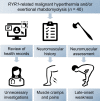Neuromuscular symptoms in patients with RYR1-related malignant hyperthermia and rhabdomyolysis
- PMID: 36751502
- PMCID: PMC9897183
- DOI: 10.1093/braincomms/fcac292
Neuromuscular symptoms in patients with RYR1-related malignant hyperthermia and rhabdomyolysis
Abstract
Malignant hyperthermia and exertional rhabdomyolysis have conventionally been considered episodic phenotypes that occur in otherwise healthy individuals in response to an external trigger. However, recent studies have demonstrated a clinical and histopathological continuum between patients with a history of malignant hyperthermia susceptibility and/or exertional rhabdomyolysis and RYR1-related congenital myopathies. We hypothesize that patients with a history of RYR1-related exertional rhabdomyolysis or malignant hyperthermia susceptibility do have permanent neuromuscular symptoms between malignant hyperthermia or exertional rhabdomyolysis episodes. We performed a prospective cross-sectional observational clinical study of neuromuscular features in patients with a history of RYR1-related exertional rhabdomyolysis and/or malignant hyperthermia susceptibility (n = 40) compared with healthy controls (n = 80). Patients with an RYR1-related congenital myopathy, manifesting as muscle weakness preceding other symptoms as well as other (neuromuscular) diseases resulting in muscle weakness were excluded. Study procedures included a standardized history of neuromuscular symptoms, a review of all relevant ancillary diagnostic tests performed up to the point of inclusion and a comprehensive, standardized neuromuscular assessment. Results of the standardized neuromuscular history were compared with healthy controls. Results of the neuromuscular assessment were compared with validated reference values. The proportion of patients suffering from cramps (P < 0.001), myalgia (P < 0.001) and exertional myalgia (P < 0.001) was higher compared with healthy controls. Healthcare professionals were consulted because of apparent neuromuscular symptoms by 17/40 (42.5%) patients and 7/80 (8.8%) healthy controls (P < 0.001). Apart from elevated creatine kinase levels in 19/40 (47.5%) patients and mild abnormalities on muscle biopsies identified in 13/16 (81.3%), ancillary investigations were normal in most patients. The Medical Research Council sum score, spirometry and results of functional measurements were also mostly normal. Three of 40 patients (7.5%) suffered from late-onset muscle weakness, most prominent in the proximal lower extremity muscles. Patients with RYR1 variants resulting in malignant hyperthermia susceptibility and/or exertional rhabdomyolysis frequently report additional neuromuscular symptoms such as myalgia and muscle cramps compared with healthy controls. These symptoms result in frequent consultation of healthcare professionals and sometimes in unnecessary invasive diagnostic procedures. Most patients do have normal strength at a younger age but may develop muscle weakness later in life.
Keywords: RYR1; exertional rhabdomyolysis; malignant hyperthermia; myopathy; ryanodine receptor-1.
© The Author(s) 2022. Published by Oxford University Press on behalf of the Guarantors of Brain.
Figures





Similar articles
-
Muscle Ultrasound Abnormalities in Individuals with RYR1-Related Malignant Hyperthermia Susceptibility.J Neuromuscul Dis. 2023;10(4):541-554. doi: 10.3233/JND-230018. J Neuromuscul Dis. 2023. PMID: 37154182 Free PMC article.
-
The neuromuscular and multisystem features of RYR1-related malignant hyperthermia and rhabdomyolysis: A study protocol.Medicine (Baltimore). 2021 Aug 20;100(33):e26999. doi: 10.1097/MD.0000000000026999. Medicine (Baltimore). 2021. PMID: 34414986 Free PMC article.
-
Mutations in RYR1 are a common cause of exertional myalgia and rhabdomyolysis.Neuromuscul Disord. 2013 Jul;23(7):540-8. doi: 10.1016/j.nmd.2013.03.008. Epub 2013 Apr 28. Neuromuscul Disord. 2013. PMID: 23628358
-
RYR1-Related Rhabdomyolysis: A Spectrum of Hypermetabolic States Due to Ryanodine Receptor Dysfunction.Curr Pharm Des. 2022;28(1):2-14. doi: 10.2174/1381612827666210804095300. Curr Pharm Des. 2022. PMID: 34348614 Review.
-
RYR1-related rhabdomyolysis: A common but probably underdiagnosed manifestation of skeletal muscle ryanodine receptor dysfunction.Rev Neurol (Paris). 2016 Oct;172(10):546-558. doi: 10.1016/j.neurol.2016.07.018. Epub 2016 Sep 20. Rev Neurol (Paris). 2016. PMID: 27663056 Review.
Cited by
-
Diagnostic Challenges in Malignant Hyperthermia and Anesthesia-Induced Rhabdomyolysis: A Case Study.Am J Case Rep. 2024 Dec 15;25:e946306. doi: 10.12659/AJCR.946306. Am J Case Rep. 2024. PMID: 39674884 Free PMC article.
-
Metabolic Myopathies in the Era of Next-Generation Sequencing.Genes (Basel). 2023 Apr 22;14(5):954. doi: 10.3390/genes14050954. Genes (Basel). 2023. PMID: 37239314 Free PMC article. Review.
-
Individuals and Families Affected by RYR1-Related Diseases: The Patient/Caregiver Perspective.J Neuromuscul Dis. 2024;11(5):1067-1083. doi: 10.3233/JND-240029. J Neuromuscul Dis. 2024. PMID: 39150833 Free PMC article.
-
A founder variant in the RYR1 gene is associated with hyperCKemia, myalgia and muscle cramps.Eur J Neurol. 2025 Jan;32(1):e16471. doi: 10.1111/ene.16471. Eur J Neurol. 2025. PMID: 39742415 Free PMC article.
-
Muscle Ultrasound Abnormalities in Individuals with RYR1-Related Malignant Hyperthermia Susceptibility.J Neuromuscul Dis. 2023;10(4):541-554. doi: 10.3233/JND-230018. J Neuromuscul Dis. 2023. PMID: 37154182 Free PMC article.
References
-
- Jungbluth H, Treves S, Zorzato F, et al. . Congenital myopathies: Disorders of excitation-contraction coupling and muscle contraction. Nat Rev Neurol. 2018;14(3):151–167. - PubMed
-
- Dlamini N, Voermans NC, Lillis S, et al. . Mutations in RYR1 are a common cause of exertional myalgia and rhabdomyolysis. Neuromuscul Disord. 2013;23(7):540–548. - PubMed
-
- Kruijt N, van den Bersselaar L, Snoeck M, et al. . RYR1-related Rhabdomyolysis: A spectrum of hypermetabolic states due to ryanodine receptor dysfunction. Curr Pharm Des. 2021;28:2–14. - PubMed
LinkOut - more resources
Full Text Sources
